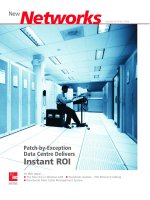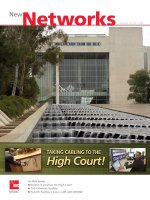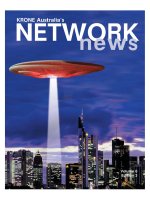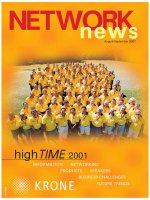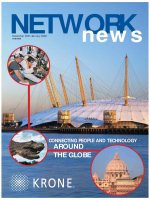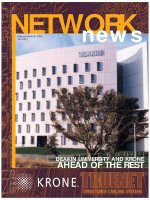Tài liệu ADC KRONE Network News - Vol.12 No.3 - 2005 doc
Bạn đang xem bản rút gọn của tài liệu. Xem và tải ngay bản đầy đủ của tài liệu tại đây (1.22 MB, 16 trang )
In this issue . . .
■
What’s the fuss about “Cat 7”?
■
ADC KRONE Joins FTTH Council
■
Central Coast Manufacturer of the Year 2005!
Network News 12_3.qxp-Layout 1 9/08/2005 12:02 PM Page 1
N
o one knows communications network
infrastructure like ADC KRONE. Sharing our
knowledge is a promise we make to you day in
and day out, to enable you to make the best
infrastructure decisions possible.
Being an inaugural member of the Fibre-To-
The-Home Council in Asia Pacific is yet another
example of this promise. Our membership in the
FTTH Council will allow us to share with you the
latest technology trends and application
requirements, guidelines for educated business
decisions and best practices for implementation
from all over the world. Dave Anderson explains
this further on page three, it’s worth a read.
Earlier this year we introduced the Australian
market to the new TrueNet
®
- the one true
network infrastructure solution. It features the
combined ADC KRONE portfolio of products for
enterprise customers. We have had considerable
interest in our portfolio additions. In fact, there
have already been significant sales of products,
particularly in TrueNet’s enhanced fibre offerings.
This shows how the benefits of the ADC KRONE
integration are delivered to you - our customer.
Glen Johnston introduces the FibreGuide range
on page twelve, a good way for you to find out
more about our new fibre offerings.
For more than 20 years ADC KRONE has
maintained a leading position in the Australian
IT&T market, demonstrating consistent excellence
in manufacturing processes and product
innovation. The numerous awards from AEEMA
and CCMA are a clear signal of our dedication to
excellence and innovation. We are pleased to
announce that in line with this proud history, for
the second consecutive year, we have won the
title of Central Coast Manufacturer of the Year.
Please join me in congratulating our Australian
staff on this achievement.
ADC KRONE succeeds because of our people
and customers. I would like to thank all of our
valued customers who continue to vote with their
orders for ADC KRONE and who enable us to
succeed where other brands have failed to grow
their market share.
Sincerely,
Bob Fitzgerald
VP Regional Director
Asia Pacific
2
❙
NETWORKnews
A NOTE FROM BOB FITZGERALD
ADC KRONE News
3 Stake In The Ground For FTTH
14 Outstanding Success At CeBIT
15 ADC KRONE Scores Three Wins
at the Central Coast
Manufacturing Awards
Technical Articles
4 What’s The Fuss About “Cat 7”
10 Planning For 10Gbps Ethernet
12 Fibreguide Fibre Management
System
Customer Stories
6 Banking On Copper
Editor: Sarah Bishop
Art Direction: Nora Collins
Website: adckrone.com/au
CONTENTS
Copyright © 2005 ADC Communications (Australia) Pty Limited.
Network News 12_3.qxp-Layout 1 9/08/2005 12:02 PM Page 2
W
ithin Australia, FTTH is a “rising sun”
technology that will ultimately replace the
current copper-based and HFC-based telephone
and cable TV networks and is currently the
subject of trials. The latest of these trials is in
Tasmania where 1,000 premises will be linked via
a FTTH network.
ADC KRONE aims to be a significant leader in
the Australian market, providing world class fibre
infrastructure. Being a global operation, ADC
KRONE is able to utilise our global scale and
locally implement best practice in technology
deployments from other markets, particularly the
United States.
ADC KRONE is engaged in negotiations with
carriers and technology providers to assist in
overcoming the new infrastructure challenges
that FTTH deployments bring, specifically with our
harsh environment and conditions.
Surveys of FTTH activity around the world show
that there are well over a million subscribers
already connected on optical fibre access, the
Asia Pacific region is the fastest growing market
and has the highest number of subscribers.
According to Dittberner Associates, Inc., the
worldwide capital expenditures related to FTTH
access technology will reach US$22.8 billion in
2013, from an estimated US$3.7 billion in 2004
and predicts that the Asia Pacific region will be
the largest market for FTTH access technology
with 52.8% of the total, or US$12 billion dollars.
The FTTH council is a non-profit organisation
whose mission is to educate, promote and
accelerate FTTH and the resulting economic and
quality of life enhancements across the Asia
Pacific region.
The inaugural Asia Pacific general meeting was
held in Yokohama Japan from 31 May - 1 June
2005 and was attended by YK Loke from our
Singapore office. Also in attendance and
presenting for ADC KRONE was Patrick Sims, who
is the Chairman of the North American FTTH
Council.
Our second participant in the forum is Alan
Crawford who is based at Asia Pacific headquarters
in Australia. Alan has a very strong background in
fibre and will be furthering our participation by
attending an upcoming meeting in Taiwan to
ensure we bring to Australia the global
knowledge in this exciting new field.
Please contact your local ADC KRONE office for
assistance in your deployments or if you would
like to be kept up to date with proceedings in the
forum.
■
NETWORKnews
❙
3
STAKE IN THE GROUND FOR FTTH
ADC KRONE is proud to announce that we are a founding member of
the Asia Pacific division of the Fibre To The Home (FTTH) Council.
Dave Anderson, Regional
Director Sales and Sales
Support, Carrier Networks,
Indo Pacific
The FTTH council is a
non-profit organisation
whose mission is to educate,
promote and accelerate FTTH
and the resulting economic
and quality of life
enhancements across the Asia
Pacific region.
Network News 12_3.qxp-Layout 1 9/08/2005 12:02 PM Page 3
I
f you want to strike fear into the heart of your
local cabling installer you need go no further
than mentioning Cat 7. If you want to strike fear
into the heart of your CFO you need go no further
than mentioning a cabling infrastructure at triple
the cost. There is a great amount of
misinformation in the marketplace about Cat 7.
This article answers some exaggerated claims and
seeks to bring facts into the discussion.
The past often helps to predict the future.
Knowing that Ethernet has evolved in speed by a
factor of 10 we can safely assume that the next
leap would move the industry to 10Gbps over
UTP. This already became a reality with fibre,
accepted in 2002 as a backbone technology. In
the design and implementation of networks we
are taught to ensure backbone speeds are 10
times greater than that of our typical
telecommunications outlet (TO). Today 4 pair
Gigabit Ethernet (1000BaseT) is the default
standard transceiver, outselling 10/100Mbps
solutions in NIC and switch port sales.
This brings us to the question of which copper
cabling solution will support 10Gig to 100m. Cat 6
was meant to offer some level of future proofing
for such an event. Unfortunately it did not! The
IEEE 802.3an 10GBaseT Working Group in 2003
identified deficiencies within Cat 6 that prohibited
its use for 10Gig to the full 100m. In doing so, this
opened up Pandora’s box to supporters of Cat 7
Class F.
So what is this magical cabling solution in Cat 7
that can support 10Gbps? It’s not only shielded
but the shield is triple-screened! It looks
conspicuously similar to the IBM Type 6 cable of
yesteryear. Hold on does this mean the
supporters of shielded solutions got it right?
Not exactly! Remember that four letter word –
cost. This was the primary driver within the IEEE
802.3an 10GBaseT Working Group (now a Task
Force) that drove them to identify why Cat 6
would not work for the full 100m and target
specifications for the cabling industry to develop
a new UTP solution that would work
i.e. Augmented Cat 6.
The IEEE 802.3an 10GBaseT Task Force is made
up primarily of active hardware members. These
are the makers of chipsets, protocols and the
boxes that house them. It’s worth noting that
these members are not there for the equitable
distribution of technology, but rather as
representatives of their companies, interested in
selling technology. This drove the development of
the new form of Cat 6 – Augmented Cat 6.
Simply speaking, take advantage of the good
characteristics within Cat 6 and augment/change
the parameters that are deemed to need
improvement.
Fortunately, the cabling industry met the
challenge in developing an Augmented Cat 6
solution that can be used for the full 100m
4
❙
NETWORKnews
WHAT’S THE FUSS ABOUT “CAT 7”?
Tim T akala discusses the timing of Cat 7 – with 10 Gig looming is it
ripe or hype?
Tim Takala,
Corporate Business
Manager
So where do you think
this leaves the
supporters/suppliers of
Cat 7? They’ve actually come
up with some pretty creative
marketing.
Network News 12_3.qxp-Layout 1 9/08/2005 12:02 PM Page 4
deployment of 10Gbps. Barriers of Alien Crosstalk
and Insertion Loss were met through clever
engineering and innovation to allow UTP cable to
yet again offer a cost effective means of
transporting high speed data.
With the above in mind do you think
companies that sell switches would like to tell
their customers that they can run 10Gig using
their new hot off the press “U beaut” 10Gig
Switch, BUT they must install Cat 7, at triple the
cost? Or that the customer’s current Cat 6
solution can be used for 55m and Augmented
Cat 6 can be installed to run the full 100m at
lower cost, typically only a 30% increase over
current Cat 6? It is a barrier to market for switch
manufacturers if the customer is required to
upgrade their existing cabling to support the
implementation new technology.
So where do you think this leaves the
supporters / suppliers of Cat 7? They’ve actually
come up with some pretty creative marketing.
For one, they are saying that Augmented Cat 6
requires additional skills beyond Cat 6. This is
simply not true. Augmented Cat 6 is Cat 6, only
engineering to mitigate the effects of alien
crosstalk. As long as the manufacturer’s
instructions are followed, the time and skill to
install the solution are the same.
They are also saying that the size of the cable is
“about 8mm OD”. This is also not true. ADC
KRONE’s version of this cable has a 6.7mm
nominal OD. This is still well below that of Cat 7.
Another argument in support of Cat 7 states
“you can split the pairs to save money”. I found this
particularly entertaining considering that Gigabit
Ethernet, much less 10Gig, requires all 4 pairs to
work! If this were done you would be left with a
network that supported 100BaseTX Ethernet at a
maximum. You might as well be installing old Cat 5
UTP. One supporter of Cat 7 was even bold enough
to suggest that you can install a single Cat 7 cable
instead of 3 Cat 5e cables to the same location. The
only logic in doing this would be that a single Cat 7
cable would cost you as much or more than 3 Cat
5e cables!
Cat 7 cabling solutions do have a place in the
market. Otherwise customers would not be
buying them. They offer excellent protection from
EMI and some enhanced security over UTP
solutions. That being said, the existing market
share says it all. Gone are the days of endless IT
funding. CFO’s are asking hard questions
regarding where funding is spent and rightfully
so. In order to make 10Gig infrastructures a viable
reality, a cost effective solution needs to be
deployed with the longest timeline to
obsolescence, as well as a justifiable return on
investment.
Augmented Cat 6 offers the ability to deliver
10Gig, to the full 100m distance of its Cat 5e and
Cat 6 predecessors, while at the same time
offering that next tenfold leap in Ethernet that its
Cat 6 predecessor could not. This is all done on an
Unshielded Twisted Pair solution that installers are
already eagerly embracing, and customers are
buying!
■
NETWORKnews
❙
5
?
“Cat 7 supporters are saying that
Augmented Cat 6 requires additional
skills beyond Cat 6. This is simply not
true. As long as the manufacturer’s
instructions are followed, the time and
skill to install the solution are the same.”
Clockwise from the
left: coaxial cable,
STP Cat 7 and UTP
Cat 6 cable.
Network News 12_3.qxp-Layout 1 9/08/2005 12:02 PM Page 5
W
hen Phil Rogerson, network manager
Europe, for ‘The Bank’ was tasked with
building a new European data centre for his
company he knew he had a tough time ahead.
Michael Crane talked to Phil and to Steve Banks,
an independent consultant retained by the Bank,
to help with the project.
The Bank - one of the major multinationals
which for security reasons we’re not
permitted to name - has a massive
presence in London with thousands
of staff, hundreds of high-
powered “traders” and all of the
services to support them.
The Bank’s European
operations are equally massive
and progress (since this scribe
reported on the building
of the previous comms
room/data centre some
seven years ago) has moved on to
such a degree that a completely new
London-based data centre was needed to support
not just UK but pan-European operations.
THE REQUIREMENTS
Responsible for the design, implementation and
management of the Bank’s physical infrastructure
throughout Europe, Phil Rogerson is acutely
aware of his organisation’s dependence on the
infrastructure he lays down - and the risk to the
business of failures in that infrastructure.
Rogerson explained, “The Bank’s traders trade
multi millions each day and almost all of our
business is either conducted electronically or relies
on IT systems. The cost to the company of
downtime is stratospheric - probably millions of
dollars per minute. They expect system availability
of at least 61 minutes in every hour and when they
want a move or change done the expectation is
yesterday, not sometime today or tomorrow!”
Of course in today’s banking business, IT is an
area they all invest in extensively because
providing information to their bank’s traders 10 or
20 milliseconds faster than their competitors gives
them the edge in that manic high-stress trader-
floor environment that we’ve all seen on the TV.
“This banking culture,” explained Rogerson,
“puts two opposing requirements on us for the
physical network. On the one hand is the need to
future proof. You only get one chance to set up a
data centre for its five to seven year life. There’s
no question of going in halfway through because
you didn’t put in fast enough cabling
infrastructure when you built it, so future
proofing is a very high priority”.
“But on the other hand, the IT infrastructure
has to be absolutely rock solid because downtime
BANKING ON COPPER
A NEW SPIN ON INVESTING FOR THE FUTURE BY A BA
‘The Bank’ – a major multinational which for security reasons we’re
not permitted to name – has just completed a 10Gig copper network
infrastructure upgrade.
Network News 12_3.qxp-Layout 1 9/08/2005 12:03 PM Page 6
is not an option. Which, of course, means that I
want tried-and-tested solutions with lots of track
record and field experience.”
The data centre itself had to be built to house
some 150 cabinets of blade-servers and storage
network devices and core Ethernet switches.
These had to interconnect together and out to
switches serving the London offices and traders,
as well as connecting masses of fibre linking the
centre to its ‘mirror’ in a secret location, and to
MAN and WAN interconnects to the European
and rest of world locations of The Bank.
Multiple fibre routes, resilient power and air-
cooling were all part of the requirements.
BREAKING NEW GROUND
“Normally,” explained Phil, “data centres are
cabled from point-to-point and usually in fibre. So
the core switches servers and routers are equipped
with fibre GBICs (Gigabit interfaces) and a fibre
patch cable is run directly from the core switch
port out to the opposite server - sometimes via a
fibre patch panel in the server cabinet”.
“But this approach,” he says, ”can often lead
to ‘finger trouble’, particularly at the core
switches where it is all too easy to accidentally
unplug or disturb the wrong port.”
Consultant Steve Banks took up the story, “To
avoid this potentially high risk problem we decided
that all of the connectivity between the switches
and active equipment had to be based around a
central patching frame so that the connections into
the switches could be regarded as ‘permanent’.
Then Phil could keep the switch cabinets locked to
avoid any down-time accidents.”
Phil and Steve had decided to adopt this policy
whether they used fibre or copper for the
interconnects using an ‘mdf-frame style’ patching
suite for best space utilisation - rather than the
conventional patch-cabinet approach.
So the overall scheme would be locked switch
cabinets with permanent cabling to the
switchside of patch panels on the patching frame,
then patch cords across to the active equipment
side of the frame, with permanent cabling to
patch panels within each active equipment
cabinet and finally patch cords to the servers and
routers in the cabinets.
Phase 1 included 50 active equipment cabinets
with 2000 patching ports on each side of the
patching frame.
Phase II, recently completed, doubles the size to
100 active cabinets containing some 400 servers,
OR THE FUTURE BY A BANK!
“We don’t need 10Gigs today, but we’re
almost certain to during the lifespan
of the data centre.”
Network News 12_3.qxp-Layout 1 9/08/2005 12:03 PM Page 7
8
❙
NETWORKnews
routers, storage devices etc., and Phase III which
is just about to start will take the total to 150
active equipment cabinets.
10G - FIBRE OR COPPER?
From a future-proofing point of view, The Bank
wanted the data centre cabling infrastructure to
be 10Gig-ready. “We don’t need 10Gigs today,”
says Phil, “but we’re almost certain to during the
lifespan of the data centre”.
“At the time we were planning the data centre
there were only two serious options - Fibre and
Category 7. Then in November 2003, ADC
KRONE demonstrated to the IEEE standards
working group (which Steve is involved with) that
they could manufacture a UTP cable very similar
to Cat 6 that would allow 10 Gigabit/s over UTP.
“Steve Banks and I spent a lot of time considering
the options”, Phil recalled. “Now that we have
OM3 multimode fibre in the market, this was a
good potential choice. In fact if ADC KRONE
hadn’t come up with CopperTen
™
when they did
it would have been our preferred choice.”
The downside of fibre, however, Phil and Steve
explained was that most of the legacy equipment
had UTP copper NICs (network interface card)
and nearly all active equipment currently ships
with Gigabit UTP ports as standard.
“So if we’d taken this option there would have
been the added expense of fibre GBIC interfaces
for all the switches and active equipment” said
Phil.
Category 7, at the time was the only ratified
standard for copper cabling that was 10 Gig
capable.
“We found Cat 7 expensive, and didn’t like the
fact it uses either a non-RJ45 connector which
isn’t backward compatible, or one that looks like
RJ-45 but has extra contacts. Also, it uses pairs-in-
metal-foil where each of five shields needs to be
terminated carefully. Too many opportunities for
errors and problems, we thought!”
Another possible solution they considered
briefly was 10GBase-CX4, which is a ratified
standard for 10Gig over copper - designed as a
cheaper replacement for fibre channel. “But with
a reach limited to 15 metres, and little field
experience we discounted it immediately” said
Rogerson.
“The only other standards based option we
had,” Steve Banks recalls, “was Category 6. But
of course this was only standardised for data
speeds up to 1 Gigabit/s although at the time
there was talk that it might do 10 Gigabit/s at up
to 55 metres”.
“After much consideration, we decided on
ADC KRONE’s CopperTen because it complied
with IEEE requirements for 10Gig and came with
a full warranty. Furthermore it was full standards
compliant to Category 6 - which meant we were
working with tried and trusted UTP and RJ-45
technology - which is what most of the world is
used to” Phil recalled.
Asked why they chose ADC KRONE, Phil replied
that The Bank believes there are major
operational benefits - particularly for a worldwide
organisation - in standardising on one
manufacturer for mission critical infrastructure.
“We decided some years ago that specifying ADC
KRONE gave us products of the highest standard
and some ‘clout’, which is more like a
partnership, where we actually work closely with
ADC KRONE on new developments that benefit
us both.”
FIBRE DEVELOPMENT
Of course, although The Bank had decided on
CopperTen for its main intra data centre cabling,
“After much consideration,
we decided on ADC KRONEs
CopperTen because it
complied with IEEE
requirements for 10Gig and
came with a full warranty.”
Network News 12_3.qxp-Layout 1 9/08/2005 12:03 PM Page 8
there’s still a massive requirement for fibre
connectivity through to the comms rooms - of
which there are three in the building, and from
thence into the London head office building. They
also go out to the Metropolitan Area and Wide
Area Networks that link this data centre to its
secret-location “mirror” and out to the Bank’s
offices throughout the world.
“We have a golden rule with fibre patch
panels,” Phil explained, “Once they’ve been
terminated and are operational we never ever
open them again. There’s just far too much risk of
fibre damage - and that’s a downtime risk we
can’t afford to take. This means that all expansion
requires additional fibre patch panels, which,
apart from the cost, can eat up very valuable
space. We worked together with ADC KRONE to
find a better, more compact solution where each
1U fibre patch panel is actually split into two 0.5U
completely independent trays. This made it far
easier to build growth capability into the fibre
pitching frames.”
POWERFUL SOLUTION
With 100 racks of active equipment there must be
a significant power requirement and Phil pointed
out three massive 500kVA UPS (uninterruptible
power supply) units operating in ‘n=1 redundancy’
and so there’s potentially one megawatt of power
being consumed in the data centre. Which led to
the next challenge: “The amount of air handling
we needed in what is a fairly low ceiling location
meant that we couldn’t use our preferred under
floor cabling techniques and had to devise an
overhead solution instead” Phil said.
Are Phil and The Bank happy with the results?
“When we went fully live in June 2004 we had
installed 2000 ports and 70kM of CopperTen.
That was completely successful and we had Phase
II with 100 active equipment cabinets up and
running earlier this year and Phase III is about to
start”.
“We have now also taken the decision to fit
CopperTen into the next phase of our major
secret-location “mirror” data centre. This has
some 500 cabinets operational, but the next 50,
being fitted now have not only 10 Gigabit’s
CopperTen, but also ADC KRONE’s yet to be
launched 10 Gigabit Intelligent Patching System -
or maybe I shouldn’t have told you about that
yet!” Phil chuckled.
■
NETWORKnews
❙
9
A
DC KRONE has assisted the not-for-profit Historical Aircraft
Restoration Society (HARS) through a sponsorship deal which
enables vital communication between their two airport buildings.
HARS works to recover and where possible, restore to flying
condition, aircraft that have played a significant role in Australian
aviation history.
HARS was faced with the challenge of connecting the two
communication buildings at their Albion Park site. With the
broadband service terminating in their airport terminal building, it was
necessary for the administration building to share the network and
connection.
”Being an airport, both hanging wires and trench digging were
impossible so the only solution was to set up a wireless connection.”
Said Kerry Gnaden, HARS volunteer. “It was best to run with a line-
of-sight technology.” HARS approached ADC KRONE with a request
for assistance. The ADC KRONE Terescope was installed in December
of 2004 as a temporary solution to facilitate the transmission of
information.
The airport is currently being expanded for regular passenger
services and HARS is aiming to make their complex as technologically
advanced as possible. Kerry explained “We are using innovative
designs and methods in the construction of the Hangar and Museum
complex, which will house our historical flying aircraft and
memorabilia. The ADC KRONE Terescope link fits in very well with
this philosophy. The new complex will form a showpiece for the
Illawarra Region as it moves towards becoming a technology driven
Region.”
■
TERESCOPE
FINDS NEW HANGAR
One of HARS collection, affectionately named “Connie”
Network News 12_3.qxp-Layout 1 9/08/2005 12:03 PM Page 9
I
nstalled cabling has always led the primary data
rate. For example, in 1995 nearly 70% of UTP
installed cabling was the 100Mbps old Category
5 cable, yet over 90% of switch port sales were
for only 10Mbps Ethernet protocol.
Similarly in 2001, Category 5 and Category 6,
which both support 1000Mbps, accounted for
over 80% of UTP cabling installed. Yet about
70% of switch port sales were for only 100Mbps.
Building owners and end users were obviously
taking advantage of the gains offered by
reputable cabling vendors having superior
products ahead of protocol requirements.
Of course, the next logical step in the data rate
is another tenfold increase from 1000Mbps to
10Gbps. With 10Gbps copper transceivers in
development today and expected to be in the
market in 2006, the cabling plant being installed
now must be able to handle the new protocol.
We know that Category 6 cabling can support
10Gbps transmission - but only to 55 metres, per
TIA TR42.7, Cat 6-TSB155. What we want is a
10Gbps UTP cabling solution that will support the
full 100 metres.
From a standards perspective, TIA TR42.7,
Cat 6A in the draft TIA-568-B.2 Addendum 10 is
the current view (July 2005) to support 10Gbps
transmission over UTP at 100 metres. Look for
compliance with this standard as you shop for
and test for a solution. The draft standards also
require full interoperability and backwards
compatibility.
The cabling industry does not drive the
electrical parameters needed to run transmission
protocols. It is the IEEE that develops proposed
protocols, understands what is needed from an
electrical perspective, and then gives international
standards bodies the responsibility for developing
measurable parameters for the cable and
connectors. When in doubt, follow the IEEE lead.
For Category 5 and Category 6 solutions, the
pair-to-pair relationship is paramount to making a
PLANNING FOR 10GBPS ETHERNET OVER UTP
UTP cabling for 10 Gigabit Ethernet is a realistic expectation for
network designers and IT managers. It’ s predictable, quantifiable and
it’ s available now.
10
❙
NETWORKnews
Peter Meijer, JP BE MSc,
RCDD, Technical Manager
and Industry Support
W
elcome to Sarah Bishop – our newly appointed Marketing Specialist for Australia & New
Zealand. In this position, Sarah will be managing marketing programs for Australia and
New Zealand, responsible for media relations, advertising, events and tradeshow presence.
Sarah joins us from Vodafone and has a breadth of experience in direct marketing and
advertising. Amongst other things she has been the face behind many of Vodafone’s successful
MMS campaigns.
As editor of Network News, Sarah would welcome your comments, suggestions or
contributions, and can be contacted by phone on (02) 4389 5364 or via email at
By Carsten Quiram, Regional Marketing Director, Asia Pacific.
NEW MARKETING SPECIALIST
AUSTRALIA & NEW ZEALAND
Network News 12_3.qxp-Layout 1 9/08/2005 12:03 PM Page 10
T OVER UTP
good cable. While the usual electrical characteristics of NEXT,
FEXT, IL and RL remain important, taming alien crosstalk
remains the toughest hurdle for any 10Gbps UTP solution at
100 metres.
Alien crosstalk is the noise heard on a pair within a cable
that is generated by another cable directly adjacent to it.
Manufacturers of active equipment do not like random
events such as alien crosstalk. While noise between pairs
within a cable can be predicted and eliminated within the
active hardware, unpredictable alien crosstalk noise cannot.
To provide the necessary separation between cables to
reduce ANEXT, manufacturers are using new cable
manufacturing techniques. For example, in CopperTen
™
cable, the use of an elliptical offset star filler achieves a high
degree of separation between pairs in adjacent cables in a
bundle. Bundled cables will then have sufficient separation
between same lay length pairs to minimise alien crosstalk to
an acceptable level. In a bundle, the random separation of
cables keeps cable pairs of the same twist rate within
different cables at a greater distance from one another -
further reducing alien crosstalk.
Because alien crosstalk presents the steepest challenge to
10Gbps over UTP, the ANEXT laboratory testing must be for
the 6-around-1 cable configuration.
It is evident that 10Gbps transmission over a copper
cabling plant will soon become a common design
specification. While lack of standards today present some
risk in the decision making process, other factors offer
guidance when choosing cable, plugs and connectors to
support future 10Gbps applications. Solutions that currently
have a Shannon’s Capacity of 18Gbps at 100 metres offer
the best assurance that the channel will support 10Gbps
transmission when standards are ratified next year.
And remember
“For Cat 6 cable and Cat 6 A, use random lay in the bundle
and tray.”
■
NETWORKnews
❙
11
ADC KRONE’s new Midspan Power over Ethernet
(PoE) controller provides a flexible way to power IP
telephony and other devices over a local area
network.
The IEEE 802.3af-compliant power source ensures
reliability of service for Ethernet devices such as VoIP
telephones, wireless access points, security cameras
etc. ADC KRONE’s Midspan PoE Controller also
eliminates the need for installation of local power at
the device, saving time and money.
FEATURES:
■
Up to 24 ports per panel in a single rack unit
(1.75 inches)
■
Optional SNMP card allows monitoring of
individual ports, as well as power shutdown
to any given port
■
Universal AC input (114/230 VAC, 50/60Hz)
■
Up to five panels can be daisy-chained so that
multiple panels can be controlled by one CPU
card and a single IP address
■
400 watt power, offering full 15.4 Watts power
to each port
■
Utilises existing infrastructure
- Same cables and FJ45 connectors
■
Offers a less expensive, faster, simpler way to set
up remote network devices
- Wi-Fi access points
- IP security cameras
- VoIP phones
MIDSPAN PoE
CONTROLLER
Of course, the next logical step
in the data rate is another
tenfold increase from
1000Mbps to 10Gbps.
Network News 12_3.qxp-Layout 1 9/08/2005 12:03 PM Page 11
12
❙
NETWORKnews
A
DC KRONE’s FibreGuide
®
Fibre Management
Systems offer the greatest breadth of optical
raceway products in the industry. In response to
customer requirements, ADC KRONE continues to
innovate and improve the FibreGuide System,
adding greater flexibility and driving down
installation time to ensure smooth deployment.
FibreGuide is a raceway system designed to
protect and route fibre optic patch cords, multi-
fibre cable assemblies and intrafacility fibre cable
(IFC) to and from fibre splice enclosures, fibre
distribution frames and fibre optic terminal
devices. FibreGuide ensures minimum bend
radius is maintained throughout the system. And
new tool-less, SnapFit
™
junctions, cover options
and Express Exit
™
drops significantly reduce the
amount of time required for installation.
The FibreGuide system is a complete set of
products designed and manufactured to ensure
total off-frame protection and ease of use. Basic
components include horizontal and vertical
straight sections, horizontal and vertical elbows,
downspouts, junctions and numerous support
hardware and flex-tube kits.
FEATURES AND BENEFITS
Speed of Installation
FibreGuide systems feature a variety of products
that allow for quick and easy installation. Express
Exit drops as well as tool-less products including
SnapFit junctions, snap-on covers and new hinged
cover options save valuable time for installers.
Speed of Deployment
The Express Exit system enables new drops to be
added or removed quickly and easily. A drop can
be added into a fully loaded raceway in seconds -
without cutting.
Raceway Flexibility
FibreGuide features 38 support structures, over
75 fittings, multiple drop options and several
other components to suit any application you create.
Fibre Protection
ADC KRONE’s broadband expertise translates into
maximum protection for your network. Minimum
bend radius is maintained throughout the system
regardless of the raceway size.
Strength and Durability
100% raceway reliability - stands up to any challenge.
SNAPFIT AND HINGED COVER OPTIONS
To drive down valuable installation time, ADC
KRONE introduces tool-less SnapFit and hinged
cover options. Featuring simple, durable plastic
hardware, these covers install in minutes and
FIBREGUIDE
®
FIBRE MANAGEMENT SYSTEMS
THE INDUSTRY’S MOST COMPREHENSIVE OPTICAL RACEWAY SYS
Glen Johnston,
Product Manager
Structured Cabling,
Indo Pacific Region
Network News 12_3.qxp-Layout 1 9/08/2005 12:03 PM Page 12
NT SYSTEMS
VE OPTICAL RACEWAY SYSTEM
require no tools. The hinged cover option
provides easy access, enabling installers and
technicians to deploy the product quickly and
easily. In addition, the covers do not need to be
fully opened for maintenance.
SnapFit Junction
ADC KRONE’s SnapFit junction is the industry’s
first completely tool-less junction. No additional
tools are needed for installation or removal. Quick
and easy to install, the FibreGuide SnapFit
junction saves valuable time and money.
Express Exits
The Fibre Guide System features a number of
innovative Express Exit options: Low profile,
50mm and 100mm options round out this
innovative product line, designed to meet your
most demanding network requirements. And
now Plenum Express Exit systems are also available.
By simply securing an Express Exit to the sidewall
of a Plenum FibreGuide straight section, jumpers
can be permanently or temporarily routed to the
fibre optic terminal (FOT) equipment or fibre
frames. No cutting is required. Positioning a drop
with a member of the Express Exit family greatly
simplifies installation, protects and integrity of
existing fibres and increases the overall flexibility
of the raceway system.
50X150 FIBREGUIDE SYSTEM
The 50x150 FibreGuide system provides another
option to securely route and protect patch cords.
Designed for height-restricted environments, this
robust system provides the same support and
system flexibility of the traditional 100x150
system while saving two inches of overhead
space. A complete set of fittings, straight
sections, junction and an Express Exit are available
along with adapters to both the 100x100 and
100x150 systems.
FibreGuide is yet another innovative product to
be released into the Australian market since the
ADC acquisition of KRONE in 2004. As our valued
customer, you will continue to see the benefits in
the joining of two great companies.
■
NETWORKnews
❙
13
Network News 12_3.qxp-Layout 1 9/08/2005 12:03 PM Page 13
C
eBIT Australia is the predominant ICT trade fair in the Asia
Pacific region. CeBIT 2005 was an outstanding success for
ADC KRONE with scores of visitors to the stand and lots of
interest in the new product portfolio.
Key areas of interest were Power over Ethernet Controllers and
ADC KRONE’s revolutionary CopperTen
™
solution.
“CeBIT is expanding from being just an IT fair to incorporate a
focus on telecommunications. This is highly valuable to both
exhibitors and visitors to the event” commented Carsten Quiram,
Asia Pacific Marketing Director, ADC KRONE. “This change is
beneficial to us, CeBIT 2005 saw 20% more qualified leads than
2004, along with a 15% increase in traffic to our stand.”
We hope to see you at CeBIT 2006!
■
14
❙
NETWORKnews
OUTSTANDING SUCCESS AT CEBIT 2005
Network News 12_3.qxp-Layout 1 9/08/2005 12:03 PM Page 14
A
long with this prestigious award, ADC
KRONE received the awards for Innovation in
Manufacturing, Large Company and Innovation
in Technology.
The Berkeley Vale manufacturing facility is the
centre of excellence for the region, recently
becoming Asia-Pacific Headquarters for ADC
KRONE.
These awards recognise the dedication of the
entire ADC KRONE team to business excellence
and innovation.
“Entering the awards provides us with an
opportunity to put our business under a
microscope and look at it from an outsiders
perspective,” said John Harris, Manufacturing
Director, Asia Pacific at ADC KRONE. “Winning
the Manufacturer of the Year Award two years
running is a real statement with regard to our
excellent staff and capabilities.”
ADC KRONE based the application on key
competencies including: commitment to the
protection of the environment, recognising
employees as their greatest asset, energy
efficiency, strategic planning, in-situ re-
engineering and performance upgrade
capabilities, long product life guarantee and
regular reviews to assess processes.
“We were thrilled to win three awards this
year,” added Mr. Harris, “we will continue to
pursue a level of excellence, setting the standard
for Manufacturing on the Central Coast and
beyond.”
■
NETWORKnews
❙
15
ADC KRONE SCORES THREE WINS
AT THE CENTRAL COAST MANUFCTURING AWARDS
For the second consecutive year, A D C KRONE has won the title of
Central Coast Manufacturer of the Y ear .
Changed your details?
Fax any changes to Club KRONE on 1800 456 266.
Contact: . . . . . . . . . . . . . . . . . . . . . . . . . . . . . . . . . . . . . . . . . . . . . . . . . . . . . . . . . . . . . . . . . . . . . . . . . . . . . . . . . . . . . . . .
Company: . . . . . . . . . . . . . . . . . . . . . . . . . . . . . . . . . . . . . . . . . . . . . . . . . . . . . . . . . . . . . . . . . . . . . . . . . . . . . . . . . . . . . . .
Address: . . . . . . . . . . . . . . . . . . . . . . . . . . . . . . . . . . . . . . . . . . . . . . . . . . . . . . . . . . . . . . . . . . . . . . . . . . . . . . . . . . . . . . . .
Suburb: . . . . . . . . . . . . . . . . . . . . . . . . . . . . . . . . .State: . . . . . . . . . . . . . . . . . . . . . . . . . . .Post Code: . . . . . . . . . . . . . . .
Phone: . . . . . . . . . . . . . . . . . . . . . . . . . . .Fax: . . . . . . . . . . . . . . . . . . . . . . . .Mobile: . . . . . . . . . . . . . . . . . . . . . . . . . . . . .
Preferred Contact Method: Preferred E-mail format:
Fax: E-mail: Html: Text:
ATT: Mark Meyer – Club KRONE Administrator Fax: 1800 456 266
Network News 12_3.qxp-Layout 1 9/08/2005 12:03 PM Page 15
I NEED ONE TRUE NETWORK
INFRASTRUCTURE SOLUTION.
TrueNet is the high-performance
structured cabling solution that meets
your unique network needs. Your one
true network infrastructure solution,
TrueNet is the integrated portfolio
of industry-leading products from
ADC KRONE.
True End-to-End Solution
Now your complete network
infrastructure needs are met by a single
global manufacturer. The TrueNet system
delivers proven cable, connectivity, and
cable management solutions for fibre,
10G Ethernet over UTP, and Category 6/5
from the data centre to the desktop.
True Performance
With TrueNet, you can push networks
to the performance edge. Innovative
products that exceed industry standards
support advanced applications today
and tomorrow.
True Reliability
Mission-critical networks rely upon
trusted TrueNet infrastructure. Built
and tested in ADC KRONE's world-class
facilities, TrueNet guarantees signal
integrity and network throughput.
I need
TrueNet
®
AUSTRALIA
2 Hereford Street, BERKELEY VALE NSW 2261
Ph: (02) 4389 5000 Fax: (02) 4388 4499
TECH SUPPORT: 1800 801 298
WEBSITE: adckrone.com/au
NEW ZEALAND
Cnr The Esplanade & Nevis St, PETONE NZ
Ph: +64 4 576 9213 Fax: +64 4 576 9243
SALES: 0800 657 663
WEBSITE: adckrone.com/nz
Network News 12_3.qxp-Layout 1 9/08/2005 12:03 PM Page 16

